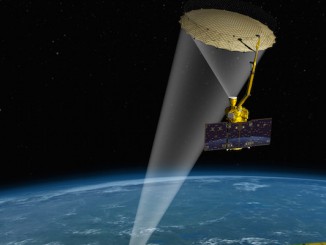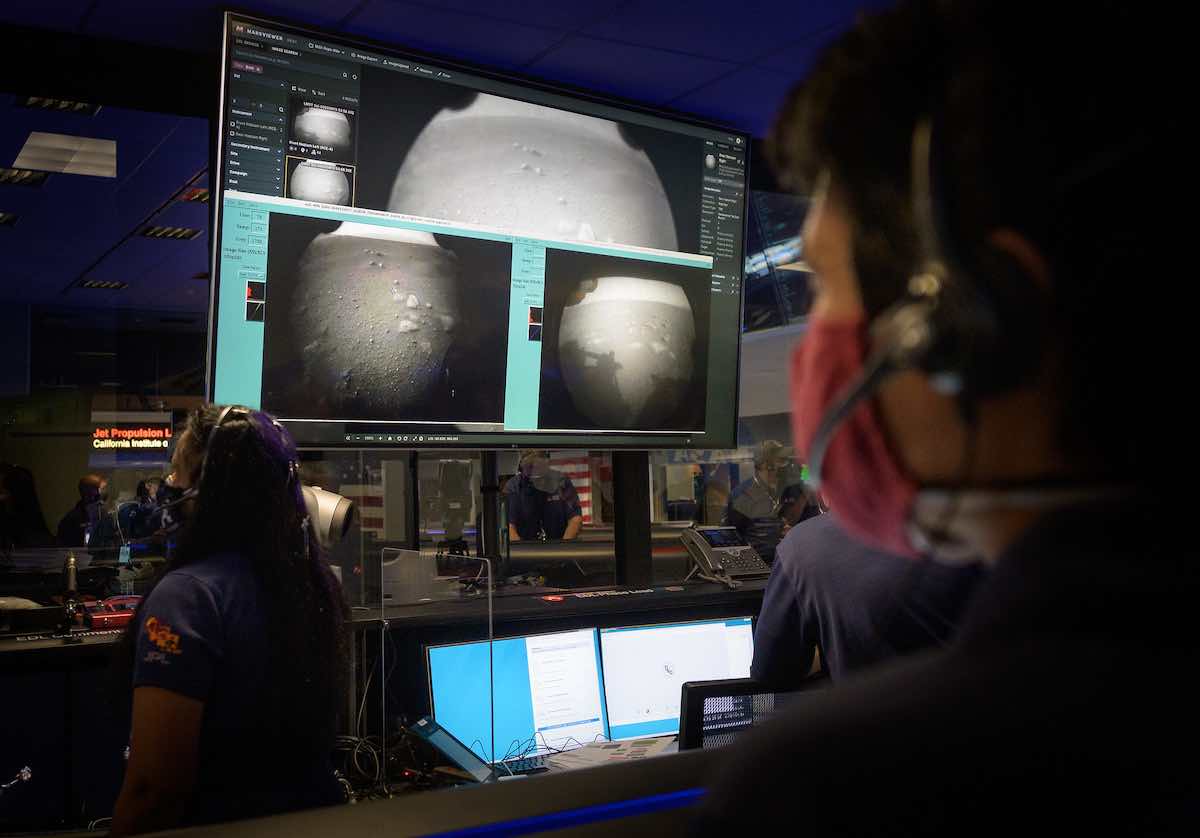
NASA’s Perseverance Mars rover set down on an ancient lakebed after a flawless plunge into the Martian atmosphere Thursday, achieving an unprecedented pinpoint landing while delivering the most sophisticated suite of science payloads ever flown to another planet.
The $2.4 billion Perseverance rover arrived at Jezero Crater, a basin that scientists say was once flooded with liquid water, after a nail-biting descent to the Red Planet’s rust-colored surface.
“Wow! We have a science mission,” said Ken Farley, Perseverance project scientist from NASA’s Jet Propulsion Laboratory.
The nuclear-powered mobile robot capped a seven-month journey from a launch pad at Cape Canaveral with a high-speed dive into the Martian atmosphere. A heat shield cocooned the rover as it streaked through the rarefied air at more than 12,100 mph (19,500 kilometers per hour).
After surviving temperatures near 2,400 degrees Fahrenheit (1,300 degrees Celsius), the rover deployed a supersonic parachute, which billowed open to slow the spacecraft to subsonic speed. Perseverance next jettisoned its heat shield, allowing a landing radar and cameras to scan the Martian surface for a safe touchdown site.
The rover’s aerodynamic backshell then released Perseverance’s rocket-powered descent stage to do the rest of the braking before landing. Eight throttleable engines on the rocket pack slowed the craft’s speed to nearly 0 mph, and Nylon cords lowered the one-ton rover to the surface.
Once Perseverance’s wheels contacted Mars, the descent stage cut the cords and diverted to crash a safe distance away, leaving the rover safely on the ground at Jezero Crater.
Here’s the moment NASA teams in California confirmed the Perseverance rover successfully landed on Mars. https://t.co/iKv65xHn6Q pic.twitter.com/OlElg6O8vZ
— Spaceflight Now (@SpaceflightNow) February 18, 2021
“We arrived at Mars moving at about 12,000 mph roughly, and just in seven short minutes, we had to slow down and gently put Perseverance down in Jezero Crater,” said Matt Wallace, Perseverance’s deputy project manager at JPL. “The system just performed flawlessly, getting through 10 or 12 Gs of deceleration, the supersonic parachute deployment, eight big main engines had to fire ,our terrain relative navigation hazard avoidance system had to perform the way it was designed. It’s never easy.”
Within minutes, the rover beamed back two low-resolution black-and-white images from its hazard cameras, providing the first-ever views of Jezero’s landscape. The images are a taste of what’s to come, and scientists expect to have high-definition video, color panoramas, and the first sound recordings from Mars beginning as soon as Friday.
In a post-landing press conference, Wallace said Perseverance is in “great shape” after arriving on Mars, and is ready for the next phase of a mission packed with firsts.
Ground teams were along for the ride Thursday. With Mars positioned some 127 million miles (204 million kilometers) from Earth, the one-way travel time for radio signals Thursday was more than 11 minutes.
That meant Perseverance followed pre-programmed commands and employed control software to land itself.
“The vehicle is going on a roller coaster ride, and you are, too,” said Allen Chen, Perseverance’s entry, descent, and landing lead at JPL.
“Things seem to be working the way you want them to go, and you start feeling good … then your stomach drops, then things are OK again,” Chen said.
“It’s an emotional roller coaster ride all the way down, and you’re second-guessing yourself as you go, even though it’s already happened,” Chen said, referring to the 11-minute time way. “It’s kind of crazy.”
Allen Chen, the Perseverance rover’s entry, descent, and landing lead, says the rover reached a safe landing site in Jezero Crater thanks to the spacecraft’s high-precision terrain relative navigation system.
Watch live: https://t.co/iKv65xHn6Q pic.twitter.com/AZihEOFVuM
— Spaceflight Now (@SpaceflightNow) February 18, 2021
Ground teams at JPL were physically distanced across multiple control rooms due to the effects of the coronavirus pandemic. Many members of the science team monitored the landing remotely.
But the engineers gathered at JPL let out a roar of applause, cheers, and exchanged fist bumps as telemetry confirmed Perseverance’s successful landing at 3:55 p.m. EST (2055 GMT).
Perseverance reused the same landing architecture demonstrated by NASA’s Curiosity rover when it landed on Mars in August 2012. But with nearly a decade of innovation since Curiosity, engineers upgraded Perseverance’s navigation algorithms to enable a more precise landing.
The rover Thursday navigated to a safe landing site free of steep slopes and boulders. Past Mars landers, without the new terrain relative navigation capability, could have not even attempted a landing on the rugged topography at Jezero Crater, according to NASA.
Chen said the rover ended up about 1.1 miles (1.7 kilometers) from the center of the landing zone.
President Joe Biden called Steve Jurczyk, NASA’s acting administrator, to congratulate the Perseverance team after the landing Thursday afternoon. The White House also tweeted a picture of Biden watching the landing from the White House.
Congratulations to NASA and everyone whose hard work made Perseverance’s historic landing possible. Today proved once again that with the power of science and American ingenuity, nothing is beyond the realm of possibility. pic.twitter.com/NzSxW6nw4k
— President Biden (@POTUS) February 18, 2021
Perseverance is the ninth U.S. spacecraft to successfully land on Mars since the Viking missions in 1976. Two international Mars missions — the Hope orbiter from the United Arab Emirates and the Tianwen 1 orbiter, lander, and rover from China — arrived at the Red Planet earlier this month.
The Chinese Tianwen 1 mission will release its lander and rover to descend to the Martian surface in May or June.
But NASA’s Perseverance rover, also known as Mars 2020, has the most ambitious goals of any Mars mission to date.
The rover’s primary objective is to search for signs of past life and gather rock samples for return to Earth by future spacecraft in development by NASA and the European Space Agency.
NASA says it spent more than $2.4 billion to design, build and prepare the Mars 2020 mission for launch. With the money budgeted to operate the rover during the trip to Mars, and for around two Earth years (one Mars year) after landing, the total mission will cost around $2.7 billion.
The 2,260-pound (1,025-kilogram) Perseverance rover is about 10 feet (3 meters) long, 9 feet (2.7 meters wide), and 7 feet (2.2 meters) tall.
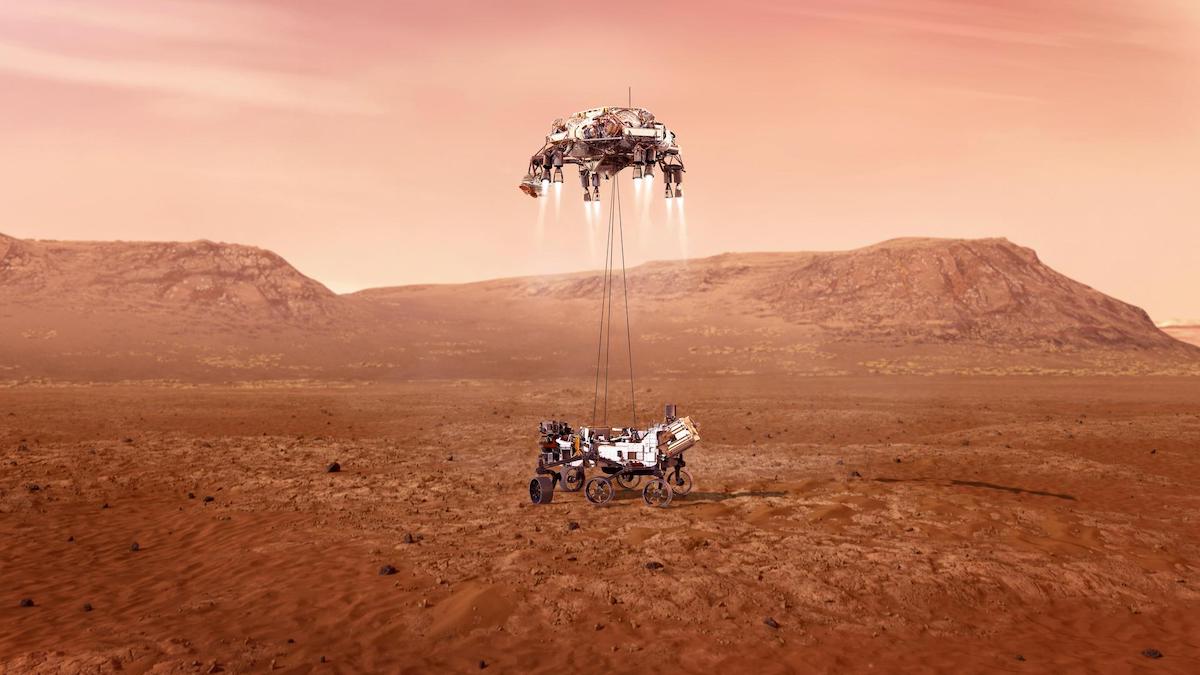
Jezero Crater, Perseverance’s landing site, was home to an ancient river delta and a lake the size of Lake Tahoe some 3.5 billion to 3.9 billion years ago. Scientists hope to find signatures of ancient life in the rocks and sediments deposited in the dried-up delta.
“This is our first mobile astrobiologist,” said Lori Glaze, head of NASA’s planetary science division. “One of its main purposes is to seek out those signs of past life on Mars.”
Perseverance was designed to land as close to the delta deposits as possible. Farley said Thursday the rover ended up near the intersection of two geologic units, and the mission’s scientific targets will likely be the rocks visible in Perseverance’s first post-landing images.
The rover was expected to downlink sharper images from its hazard cameras Thursday night through a communications relay with the European ExoMars Trace Gas Orbiter, along with the first views from cameras that recorded high-resolution views throughout the spacecraft’s descent. Perseverance carried 25 cameras to Mars, more than any previous mission to the Red Planet.
Wallace said NASA aims to release the new imagery during a press conference Friday.
“For the first time, we’re going to be able to see ourselves, in high-definition video, land on another planet,” Wallace said Thursday.
Commercial ruggedized cameras were pointing up at the rover’s supersonic parachute, and one on the descent stage looked down at the rover as it prepared for touchdown suspended under Nylon bridles. Other cameras mounted on the rover were programmed to record views looking up and down during the landing.
“We think we have captured some pretty spectacular video, and they come with a microphone as well,” Wallace said. Perseverance has the first microphones flown to Mars.
“I think that’s really going to be something to see,” he said.
Ground teams have mapped out a carefully-choreographed activation and test sequence for Perseverance over the next several weeks. The rover opened lens covers and released its high-gain communications antenna soon after landing Thursday. If all goes well, the high-gain antenna could obtain a lock with NASA’s Deep Space Network as soon as Friday to enable faster data transfers between Earth and Mars, according to Jennifer Trosper, Perseverance’s deputy project manager at JPL.
Trosper said engineers will spend the first five days — known as sols on Mars — after landing to stabilize the rover’s power, thermal, and communications systems before loading a software update into the spacecraft’s computers next week.
A remote sensing mast with the rover’s panoramic cameras, science instruments, and a Martian weather station will be raised Saturday, according to Trosper. In parallel with the rover checkouts, controllers will run the rover’s seven scientific payloads through health tests and recharge Perseverance’s battery, fed by a radioactive plutonium power source.
Perseverance will take its first color panoramas this weekend.
After uploading updated software next week, ground teams at JPL will unlimber the rover’s robotic arm and send commands for Perseverance to perform its first test drive, likely by rolling about 16 feet (5 meters) forward and background.
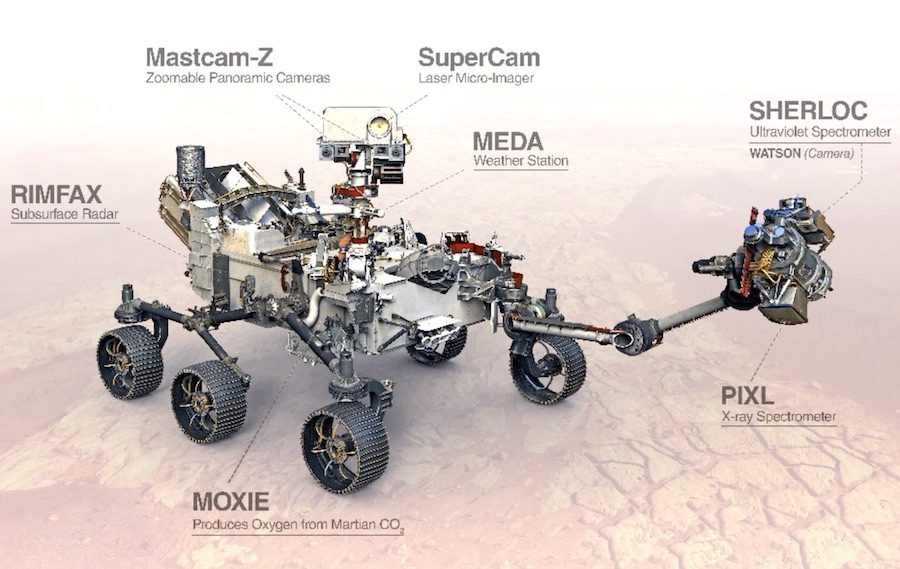
One of Perseverance’s first tasks after completing post-landing checkouts will be to drive to a nearby location to release NASA’s Ingenuity helicopter from the rover’s belly pan. The rover will drive away to a distance of at least 330 feet (100 meters) before the helicopter flies for the first time.
That moment will be historic. The tiny 4-pound (1.8-kilogram) robot will try to become the first aircraft to fly through the atmosphere of another planet.
“Human beings have never flown a rotorcraft outside of our own Earth’s atmosphere, so this will be very much a Wright Brothers moment, except at another planet,” said MiMi Aung, project manager for the Ingenuity helicopter at JPL, in an interview before Perseverance’s launch last July.
Trosper said Perseverance might be ready to start moving to the helicopter test site in about three weeks, and it might take about 10 days to reach the flight location, depending on the site selected by NASA managers.
Ground controllers will program the helicopter to perform a series of test flights during a planned 30-day campaign, beginning with a relatively simple up-and-down flight lasting less than 30 seconds, Aung said. Then the team will attempt more daring test flights.
The helicopter will fly autonomously, without real-time input from ground controllers millions of miles away. The drone carries two cameras, and telemetry from the helicopter will be routed through a base station on the rover. The Perseverance rover also might be able to take pictures of the helicopter in flight.
NASA officials approved adding the helicopter to the Mars 2020 mission in 2018. The mission cost around $80 million to design and develop, and will cost another $5 million to operate. Agency officials hope the helicopter will prove out aerial reconnaissance as a new method of interplanetary exploration.
Wallace, Perseverance’s deputy project manager, said this week the Ingenuity helicopter is much like NASA’s Sojourner rover, which became the first mobile scout on Mars in 1997 and paved the way for future rovers.
“I worked on Sojourner, and there was a lot of uncertainty at the time as to whether or not we’d ever really be able to utilize this technology, and we found very quickly that having a mobile capability on the surface of Mars was incredibly valuable,” Wallace said. “When you look at Ingenuity, it looks very much the same. It’s a technology demonstration. Its objective is not tied into the science of this mission. But the potential for aerial reconnaissance and exploration in the future, using this type of technology, is is terrific. It’s not just on Mars, but other places as well.”
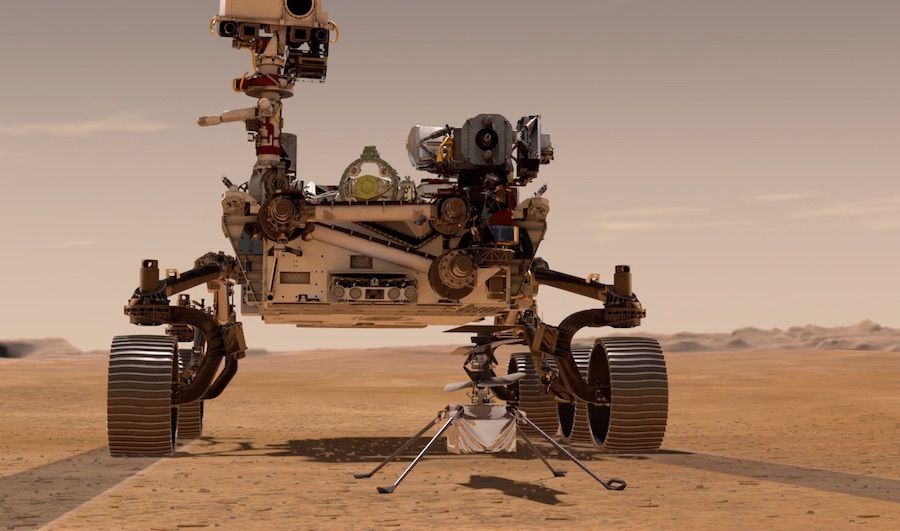
Trosper said Perseverance could be in position for the helicopter test flights this spring, then will move into the mission’s science campaign to begin examining the geology and ancient habitability of Jezero Crater.
That will lead to the first use of the rover’s drill to extract core samples from rocks in the summer, she said.
Members of Perseverance’s team say the hardware necessary to collect the rock samples and seal them inside ultra-clean tubes was the most complex undertaking of NASA’s Mars program to date. The rover has 43 sample tubes on-board, each sheathed in a gold-colored cylindrical enclosure, providing an extra layer of contamination protection. The tubes rode to Mars inside the housings, and they will be returned to their sheaths once filled with Martian rock samples.
The tubes are about the size and shape of a slim cigar, and the 43 cylinders include “witness tubes” or blanks, which will allow scientists to cross-check rock and sediment specimens returned to Earth for contamination.
“Those samples tubes are part of a Sample and Caching System, which is one of our biggest engineering developments for this mission,” said Adam Steltzner, chief engineer on the Mars 2020 mission, before the launch last year. “We get to Mars largely like the Curiosity rover got to Mars, but we need to do something very different once we’re on Mars. We must take these core samples, seal them hermetically and sterilely, and then produce a cache of samples for eventual return to Earth.”
The rover has a 7-foot-long (2-meter) robotic arm with a coring drill fixed on a 99-pound (45-kilogram) turret on the end. The longer robotic arm will work in concert with a smaller 1.6-foot-long (0.5-meter) robotic manipulator inside the belly of the rover, which will pick up sample tubes for transfer to the main arm for drilling.
Steltzner said the rover’s sampling system actually consists of three different robots.
“Out at the end of our robotic arm — that’s the first robot — is a coring drill that uses rotary percussive action like we have used similarly and previously on Mars with the Curiosity mission, except rather just generating powder, this creates an annular groove in the rock and breaks off a core sample,” Steltzner said.
During each sample collection, the core sample will go directly into the tube attached to the drill.
“That bit and the sample tube are brought back by the robotic arm — our first robot — into the second robot, our bit carousel, which receives the … filled sample tube and delivers it to a very fine and detailed robot, the sample handling arm inside the belly of the beast, in which the sample is then assessed, its volume is measured, images are taken, and it is sealed and placed back into storage for eventually being placed in a cache on the surface.”
The portion of the caching system inside the rover is called the Adaptive Caching Assembly, which consists of more than 3,000 parts alone.
The design of the drill and sample tubes is intended to preserve the distribution minerals cored from Martian rocks. The system is also intended to collect samples directly from softer soils.
Besides the sampling system, Perseverance hosts seven scientific instruments.
Two of the instruments, named PIXL and SHERLOC, are located alongside the coring drill on the robotic arm’s turret. They will scan Martian rocks to determine their chemical composition and search for organic materials, providing key inputs into decisions by ground teams on which rocks to drill.
The Perseverance rover also carries the SuperCam instrument, an intricate suite of sensors, including a camera, laser and spectrometers, designed to zap Martian rocks from more than 20 feet (6 meters) away to measure their chemical and mineral make-up, with the ability to identify organic molecules.
Developed by an international team in the United States, France and Spain, the SuperCam instrument is an upgraded version of the ChemCam instrument currently operating on NASA’s Curiosity Mars rover.
The instruments mounted inside the rover’s main body include MOXIE, which will demonstrate the production of oxygen from carbon dioxide in the atmosphere of Mars, a capability that future astronaut explorers could use on the Red Planet. A Norwegian-developed ground-penetrating radar on the rover named RIMFAX will study the planet’s underground geologic structure, yielding data on subsurface layers and soil strength which could help designers of larger landers designed to carry people to Mars.
The mission also carries a weather station and the first camera on Mars with a zoom function. That camera system, located on top of Perseverance’s remote sensing mast to be raised this weekend, is named Mastcam-Z and will record video and 360-degree panoramas.
The differences between Perseverance and NASA’s predecessor Curiosity rover do not stop at the science payload or the Ingenuity helicopter.
The Perseverance rover also features aluminum wheels with thicker skin and modified treads to avoid damage observed on Curiosity’s wheels on Mars. NASA’s new Mars rover weighs about 278 pounds (126 kilograms) more than Curiosity.
The benefit of another decade of technological advancement since Curiosity’s launch, and the budding fruits of NASA’s partnership with ESA on a Mars Sample Return program, moves scientists closer to addressing the question of whether life took hold elsewhere in the solar system.
Assuming Perseverance’s mission is a success, and funding and technical plans remain on track, NASA and ESA could launch missions as soon as 2026 with a European-built Mars rover to retrieve the specimens collected by the Mars 2020 mission. The rover will deliver the material to a U.S.-supplied solid-fueled booster to shoot the samples from Mars into space, a feat never before attempted on another planet.
A separate spacecraft provided by ESA will link up with the samples in orbit around Mars, then head for Earth before releasing a NASA re-entry capsule containing the Martian material to complete the first round-trip interplanetary mission no earlier than 2031.
Then scientists will get to work analyzing the samples. They will look for chemical signatures in the core samples that might suggest life once existed on Mars.
Among other objectives, NASA’s two Viking landers carried instruments to search for signs of life on Mars when they landed on the Red Planet in 1976. But the robotic landers did not produce any verifiable confirmation of life, and Mars missions since Viking have followed the trail of water, seeking evidence that the Red Planet once harbored environments that could have supported basic life forms.
Two other NASA robots are still exploring the surface of Mars. Curiosity has been surveying Mount Sharp in Gale Crater since 2012, and the stationary InSight seismic station landed on Mars in 2018.
Email the author.
Follow Stephen Clark on Twitter: @StephenClark1.

